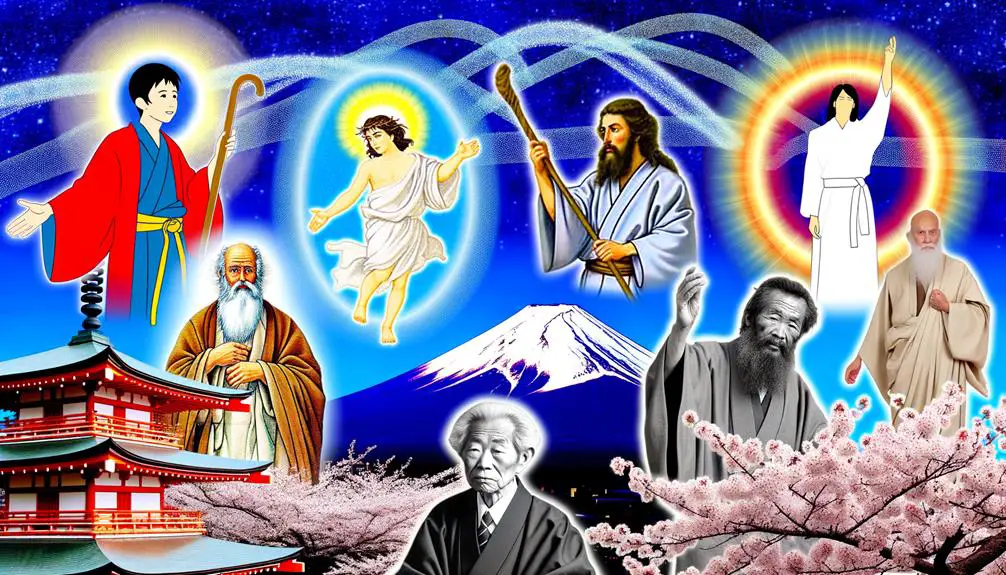Kneel into a journey of faith, language, and culture as we uncover the monumental task of translating the entire Bible into Japanese.

The Whole Bible in Japanese
As they say, 'Lost in translation' might be your first thought when considering the monumental task of translating the entire Bible into Japanese. You're about to embark on a journey that weaves through centuries of history, highlighting the intricate challenges and the key figures who dedicated their lives to making the scriptures accessible to Japanese speakers.
From ancient methodologies to modern adaptations, the cultural impact of this colossal work cannot be understated. Yet, as you stand on the brink of uncovering the depths of this endeavor, one can't help but wonder how the future perspectives of such translations will shape the understanding and accessibility of sacred texts in a rapidly evolving world.
Key Takeaways
- The translation of the Bible into Japanese began in the 16th century, reflecting deep historical and cultural exchanges.
- Innovations in language and adaptation to Japanese culture were pivotal in making the Bible resonate with the Japanese people.
- Collaborative efforts involving linguists, theologians, and native speakers have been crucial for accurate and culturally sensitive translations.
- Modern adaptations and technology, such as digital Bibles and podcasts, increase accessibility and relevance for a diverse audience in Japan.
Historical Background

The translation of the Bible into Japanese, a monumental task, initially began in the 16th century amidst a backdrop of cultural and religious exchange between Japan and the West. This period marked the onset of a complex journey, not only in the dissemination of Christian scriptures but also in the evolution of the Japanese language itself. You're delving into a narrative where language and faith intersect, revealing the intricate process of making the sacred texts accessible to a Japanese audience.
Scripture dissemination in Japan faced unique challenges. The translators' endeavor wasn't merely linguistic but also cultural, as they sought to convey the profound theological concepts of Christianity in a manner that resonated with the Japanese context. This task necessitated a deep understanding of both the source texts and the linguistic nuances of Japanese. It's important to recognize that during this era, the Japanese language was undergoing significant changes. The infusion of Western ideas, coupled with the introduction of Christianity, accelerated language evolution, impacting both vocabulary and syntax.
As you analyze this historical journey, it becomes evident that the translation of the Bible into Japanese wasn't just about rendering words from one language to another. It was a complex process of cultural adaptation and linguistic innovation. The translators had to navigate the delicate balance between fidelity to the original texts and the need to make these texts comprehensible and relevant to a Japanese audience. This endeavor highlights the dynamic relationship between language evolution and scripture dissemination, underscoring the profound impact of religious texts on linguistic development and cultural integration.
Translation Challenges
Navigating the intricate process of translating the Bible into Japanese, translators encountered numerous challenges that went beyond mere linguistic barriers. The task demanded not only a deep understanding of both source and target languages but also an acute sensitivity to cultural and religious nuances. This process highlighted the critical role of linguistic nuances and religious terminology in creating a translation that was both accurate and accessible to the Japanese audience.
Key challenges included:
- Cultural Contextualization: Adapting biblical stories and concepts to fit within the Japanese cultural framework without losing their original meaning or significance.
- Linguistic Nuances: Capturing the subtle nuances of the original Hebrew, Aramaic, and Greek texts in Japanese, which often required innovative linguistic solutions.
- Religious Terminology: Translating Judeo-Christian terms into a language with a primarily Shinto and Buddhist religious landscape posed significant difficulties. Finding equivalent terms that conveyed the same depth and breadth of meaning was a meticulous task.
- Reading Accessibility: Ensuring the translated text was accessible to a broad audience, from scholars to laypersons, necessitated a delicate balance between scholarly precision and everyday readability.
- Historical and Theological Accuracy: Maintaining the historical and theological integrity of the original texts while making them understandable in a completely different cultural and religious context.
These challenges underscored the complexity of translating sacred texts. Translators had to navigate a delicate interplay between fidelity to the original texts and the need to make these texts resonate with a Japanese audience, all while respecting the profound religious and cultural implications of their work.
Key Figures and Contributions

Several key figures emerged throughout the translation process, each making pivotal contributions that shaped the final Japanese version of the Bible. These translation pioneers dedicated their lives to ensuring the integrity and scriptural fidelity of the text, navigating linguistic, cultural, and theological challenges with remarkable skill.
One notable contributor was James Curtis Hepburn, who, apart from his medical missions, laid foundational work for the translation through his development of a Romanized system for the Japanese language. This innovation not only facilitated easier learning and teaching of Japanese for foreigners but also significantly impacted the translation process by providing a consistent framework for transliteration.
Uchimura Kanzo, another pivotal figure, brought a unique perspective to the translation efforts. His deep understanding of both Japanese culture and Christian theology allowed him to bridge the gap between the ancient texts and contemporary Japanese society. Kanzo's contributions were instrumental in ensuring that the translation remained faithful to the original Scriptures while being accessible and understandable to the Japanese reader.
Murata Harukichi, a scholar of Hebrew and Greek, played a crucial role in scrutinizing the scriptural fidelity of the translation. His expertise ensured that the nuanced meanings of the original texts were accurately conveyed in Japanese, preserving the depth and richness of the biblical message.
These individuals, among others, exemplified a commitment to scriptural fidelity and cultural sensitivity. Their collective efforts resulted in a translation that not only conveyed the theological richness of the Bible but also resonated with the Japanese people, facilitating a deeper understanding of the Christian faith.
Methodologies Employed

In exploring the methodologies employed in translating the Bible into Japanese, one must consider the intricate blend of linguistic precision, cultural sensitivity, and theological acumen that guided the translators' efforts. The process wasn't merely about converting words from one language to another but about rendering the profound theological concepts accessible and meaningful to the Japanese audience while respecting linguistic diversity.
The methodologies employed included:
- Extensive Use of Translation Software: Advanced translation software played a crucial role in ensuring accuracy and consistency across the voluminous texts. These tools facilitated the handling of ancient languages, contributing to a more efficient and precise translation process.
- Collaborative Efforts Across Linguistic Experts: The project harnessed the expertise of linguists, theologians, and native speakers, ensuring a multifaceted approach to translation. This collective endeavor aimed at achieving a balance between fidelity to the original texts and the nuances of Japanese language and culture.
- Iterative Review and Revision Cycles: The translation underwent multiple rounds of reviews and revisions. This iterative process allowed for the refinement of theological concepts and linguistic expressions, ensuring they resonated with the target audience.
- Engagement with Linguistic Diversity: Recognizing the variety within the Japanese language, the translation team aimed to produce a version that was accessible to speakers of different dialects, thereby embracing the country's linguistic diversity.
- Theological Workshops and Seminars: Engaging in comprehensive theological discussions, the team ensured that the translated text remained faithful to the original scriptures' intent and meaning, bridging cultural and historical gaps.
These methodologies underscored a commitment to scholarly rigor, linguistic finesse, and cultural respect, ensuring the translated Bible was both accurate and accessible to the Japanese faithful.
Cultural Impact

The translation of the Bible into Japanese has significantly reshaped the cultural and spiritual landscape of the country, opening up new avenues for dialogue and understanding. This monumental task not only introduced Christianity's doctrinal tenets but also fostered an environment for religious syncretism and social integration. You're now witnessing how this sacred text, once foreign, has woven itself into the fabric of Japanese society, creating a unique blend of religious practices and beliefs.
Aspect |
Impact |
|---|---|
Religious Syncretism |
The blend of Shinto, Buddhism, and Christianity, creating a uniquely Japanese spirituality. |
Social Integration |
The Bible's role in fostering understanding and tolerance among diverse religious communities. |
Cultural Dialogue |
Enhanced exchanges between Japan and the West, promoting mutual respect and understanding. |
This integration has not been without its challenges. You've observed how the initial resistance to Western religious concepts gradually gave way to a more inclusive approach, allowing for a richer, more diverse spiritual discourse. The adaptability and openness of the Japanese people have played a crucial role in this process, enabling a seamless melding of the Bible's teachings with native belief systems.
Moreover, the impact of the Bible's translation extends beyond the confines of religious practice, contributing to the broader social integration by promoting values of compassion, tolerance, and community. This has facilitated a deeper understanding and respect for the intrinsic worth of diverse cultural and spiritual traditions, enriching the Japanese societal mosaic.
In essence, the translation of the Bible into Japanese has acted as a catalyst for cultural and spiritual enrichment, highlighting the potential for harmony and mutual growth in the midst of diversity.
Modern Adaptations

Amid the digital era, you observe how modern adaptations of the Bible in Japanese have transcended traditional print formats, venturing into digital applications and multimedia platforms to engage a wider audience. This evolution mirrors broader shifts in language and literary styles, facilitating a more inclusive and accessible approach to biblical texts.
The transformation encompasses several pivotal adaptations:
- Digital Bibles: Applications for smartphones and tablets offer interactive features such as searchable texts, annotations, and cross-references, making study and reflection more dynamic.
- Audiobooks and Podcasts: These formats cater to the contemporary lifestyle, allowing individuals to engage with the scriptures during commutes or through personal meditation sessions.
- Animated Stories: By harnessing the popularity of anime and manga, biblical stories are reimagined for younger audiences, fostering early engagement with the scripture.
- Social Media Platforms: Short, impactful messages, and discussions about biblical passages on these platforms invite interaction and reflection among a diverse audience.
- Virtual Reality Experiences: These immersive experiences offer a novel way to explore biblical landscapes and stories, enriching understanding and empathy through a simulated presence in historical contexts.
These adaptations reflect a nuanced understanding of language evolution and the shifting preferences in literary styles among Japanese speakers. By embracing digital and multimedia formats, the Bible in Japanese not only stays relevant but also resonates more deeply with a society that's increasingly interconnected through technology. This approach not only democratizes access to religious texts but also enriches the spiritual landscape through a variety of sensory and intellectual experiences.
Future Perspectives

As you explore the future perspectives of translating the Bible into Japanese, you'll encounter the intricate challenge of cultural adaptation. This process not only tests the linguistic precision but also the ability to resonate with a diverse audience, potentially expanding its reach.
Moreover, the emphasis on digital accessibility initiatives promises to redefine the modes of engagement and consumption for this sacred text.
Cultural Adaptation Challenges
Translating the entire Bible into Japanese presents significant cultural adaptation challenges, especially when considering future linguistic shifts and societal changes. You're tasked with navigating language nuances and religious symbolism, ensuring the sacred text resonates with a modern Japanese audience.
- Capturing the essence of ancient narratives in contemporary Japanese, considering evolving language nuances
- Interpreting religious symbolism in ways that are meaningful and accessible to Japanese readers
- Balancing fidelity to the original text with cultural sensitivities and norms
- Addressing potential theological implications of language choices, ensuring doctrinal integrity
- Anticipating future changes in societal values and their impact on language and interpretation
This process demands a deep understanding of both source and target cultures, along with a forward-looking perspective on language evolution and societal trends.
Potential Audience Growth
Exploring the potential for audience growth involves meticulously analyzing demographic trends and shifts in cultural engagement with religious texts in Japan. Overcoming language barriers through translation initiatives can significantly enhance accessibility, catering to a wider audience. A demographic analysis reveals key segments that may exhibit increased interest in religious texts when language is not a barrier.
Demographic Segment |
Potential for Growth |
|---|---|
Youth (18-34) |
High |
Elderly (65+) |
Moderate |
Non-native Residents |
High |
These segments suggest a diverse potential audience, from young adults seeking spiritual guidance to non-native residents searching for cultural integration. Addressing language barriers, therefore, not only broadens the audience but also deepens the cultural resonance of the Bible in Japan's multifaceted society.
Digital Accessibility Initiatives
Digital accessibility initiatives represent a pivotal step in ensuring that the entire Bible in Japanese reaches a broader, more diverse audience effectively. These initiatives aren't just about making content available; they're about creating an inclusive environment where everyone can engage with the scriptures seamlessly.
- Implementing responsive website design ensures compatibility across devices.
- Adhering to Web Content Accessibility Guidelines (WCAG) bolsters usability for individuals with disabilities.
- Incorporating user feedback loops improves site navigation and content presentation.
- Utilizing alternative text for images enhances comprehension for visually impaired users.
- Offering downloadable formats in various reading aids caters to diverse preferences and needs.
Frequently Asked Questions
How Does the Japanese Translation of the Bible Address Linguistic Nuances Specific to Hebrew and Greek, Such as Idiomatic Expressions or Culturally Specific References, That Do Not Have Direct Counterparts in Japanese?
When tackling the translation of idiomatic expressions and culturally specific references from Hebrew and Greek to Japanese, translators employ various methodologies. They often opt for dynamic equivalence to convey the original's essence, considering language evolution and cultural differences. This approach ensures that the translated text resonates with Japanese readers while preserving the original meanings.
Analyzing these techniques reveals the complexities and precision required in such scholarly translation efforts.
Are There Any Notable Differences in the Reception or Interpretation of the Japanese Bible Among Different Christian Denominations in Japan, Such as Protestant, Catholic, and Orthodox Christians?
You're diving into a complex world where translation methodology and denominational demographics play crucial roles.
Different Christian denominations in Japan, from Protestant to Catholic and Orthodox, often perceive and interpret the Bible in distinct ways. These variances aren't just about theology but also about how cultural nuances and linguistic challenges are navigated in translations.
It's a fascinating exploration of faith, language, and identity that shapes the spiritual landscape in Japan.
How Has the Japanese Bible Been Incorporated Into or Influenced Japanese Literature, Art, or Popular Media Outside of Religious Contexts?
You're curious about how the Japanese Bible has shaped non-religious aspects of culture, particularly in literature, art, and media.
Interestingly, its narratives and themes have found their way into anime adaptations and manga versions, revealing a significant cultural penetration.
These adaptations often recontextualize biblical stories, making them accessible and engaging to a wider audience, thereby illustrating the profound influence of biblical literature on Japanese popular media beyond its original religious intent.
What Role Has the Japanese Bible Played in Interfaith Dialogue or Relationships Between Christians and Practitioners of Other Religions in Japan, Such as Shinto and Buddhism?
You're standing at a crossroads where cultures and beliefs intersect.
The Japanese Bible has been a bridge in this landscape, especially in interfaith ceremonies and religious festivals. It promotes understanding and dialogue between Christians and followers of Shinto and Buddhism in Japan.
This sacred text doesn't just whisper wisdom to its adherents; it's a catalyst for conversation and collaboration, fostering a deeper respect and appreciation among Japan's diverse religious communities.
How Do Japanese Bible Study Groups or Communities Approach the Study of the Bible Differently From Those in Western Countries, Considering Both Cultural and Linguistic Differences?
In Japanese Bible study groups, you'll find that study materials often include both local translations and Western commentaries, bridging linguistic gaps. Discussion etiquette leans towards consensus-building, reflecting a cultural preference for harmony.
This contrasts with Western groups, where debates may be more confrontational. Additionally, cultural differences shape interpretations, with Japanese communities perhaps emphasizing collective responsibility over individualism found in Western readings, offering a nuanced study experience.
Conclusion
In concluding, you've navigated the intricate journey of translating the entire Bible into Japanese, confronting numerous challenges and witnessing the profound cultural resonance this monumental task has engendered.
Notably, a compelling statistic highlights this endeavor's impact: over 600,000 copies have been distributed in Japan alone, underscoring the translation's significant role in bridging linguistic and cultural divides.
This endeavor not only showcases the diligent efforts of key figures but also sets a precedent for future translation projects, promising ongoing intercultural dialogue and understanding.



Sign up